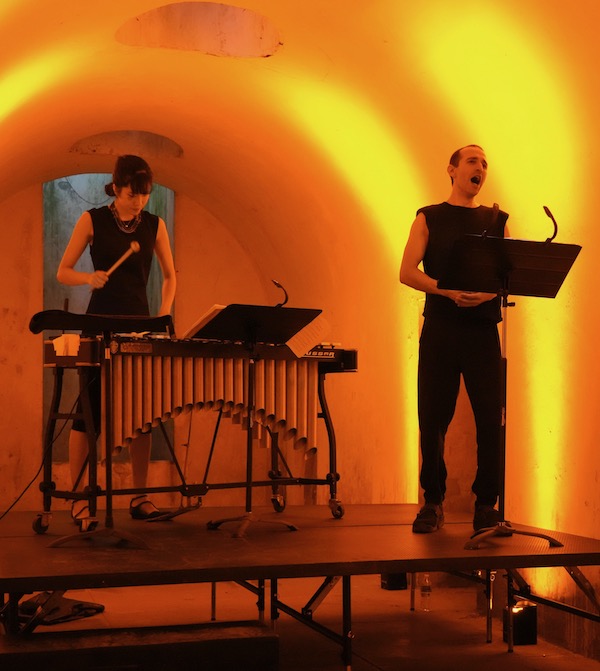With rich advocacy, a remarkable song cycle receives a powerful world premiere

It sounded ominous, at the very least: Something called “Death of Classical” was presenting a concert in a graveyard.
Happily, however, reports of the demise of this musical genre were—once again—greatly exaggerated. The vibrant world premiere of Aaron Siegel’s song-cycle Watching Birds at the End of the World, performed by countertenor Anthony Roth Costanzo and vibraphonist Sae Hashimoto Thursday night in the Catacombs of Brooklyn’s historic Green-Wood Cemetery, put an end to any such thoughts.
If this thing we call “classical” is perpetually endangered, it is also constantly being reborn, thanks to enterprising composers and performers, and also outside-the-proscenium presenters such as Death of Classical’s Andrew Ousley.
In this premiere—performed twice Thursday night to accommodate ticket demand—Siegel, a percussionist and composer known for weaving intricate sound environments with ensembles of mallet instruments, pared his language to a few elegant vibraphone riffs interacting lieder-style with the voice. The resonance of the performing space—a long, candlelit tunnel, barrel-vaulted and just wide enough to seat four across—provided all the “orchestration” needed for the 14 concise songs.
The texts, by the composer, were taut, often melancholy meditations on life and loss, sometimes solitary, sometimes addressed to a lover. Moderate andante tempos prevailed in most of the settings, with singer Costanzo—for whom these songs were composed–articulating the poems’ evocative images in a forthright yet infinitely nuanced delivery, saving operatic vibrato for the occasional emotional surge.
Within these stylistic constraints, composer and performers found endless variety. Hashimoto’s vibraphone could be a patter of rain in one song and a vast, room-filling hum in another. In the song “Light,” Costanzo’s diminuendo became an overtone in the instrumental glow, while later, in “Ghosts,” the singer seemed a distinctly corporeal human presence amid the instrument’s ectoplasmic shimmers. Harmonies could be a static background with startling highlights or strongly functional, driving the expression.
Changing mallets and touches and resonance settings, Hashimoto drew an exceptional range of colors from her instrument, sometimes in counterpoint with each other, as in the layered opening to “Truth.” Her samba beat gently animated the evanescent “Song,” like long-ago fun fleetingly remembered.
An outlier in this cycle was the twelfth song, “Hell,” a bitter scherzo in which a cubicle worker dreams, to hammering dissonances, of “the thrill of going solo/through the sheetrock.” Despite its title, the following song, “Loss,” restored order with chiming chords and imagery of lovers clinging together despite a universe trying to tear them apart. Costanzo conveyed the strength of that bond in a vocal timbre like hammered brass.
That left only the brief final song, “Mystery,” whose entire text read, “I used to think/that some time I’d see/all of the great mystery.” Lighter bells chimed as the singer closed the song and the cycle on a note of childlike wonder.
In the end, while the mortuary trappings added their resonance (both literal and metaphorical), the triumph of Watching Birds at the End of the World was mostly due to the music and words by the composer/poet and his imaginative performers. It wasn’t hard to imagine this work having a powerful effect on a plain concert stage. Maybe even one with a proscenium.
Death of Classical presents Stewart Goodyear and Jed Distler performing Mahler’s Symphony No. 9 arranged for piano four-hands, 6 p.m. and 7:30 p.m. August 6-8 at the Green-Wood Cemetery, Brooklyn. deathofclassical.com.



Posted Jul 30, 2022 at 9:38 pm by Elizabeth Pomeroy`
This beautifully detailed review makes me think of the experience of hearing musicians perform in the dome of the 100-inch telescope on Mt. Wilson in California. Also Los Angeles used to have a series called “Chamber Music in Historic Places,” where an unexpected setting might provide surprising resonance and atmosphere. Matching the music selected and the venue can be an art in itself. Well done, reviewer Wright.